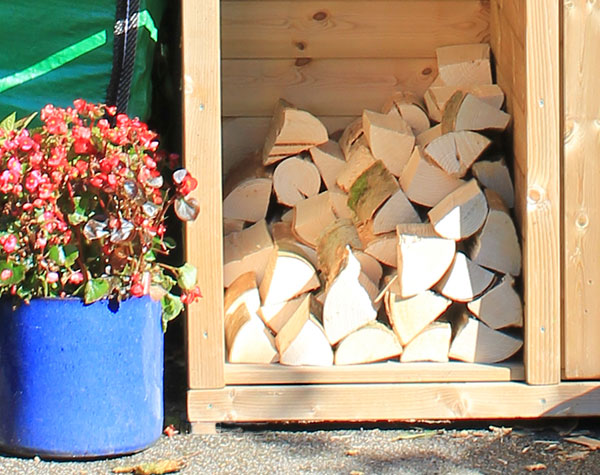Why You Should Season Your Logs
Regardless of what quantity and quality of wood you are burning, it should be properly seasoned to create the best fire. Drying wood in your log store will mean that you know your wood will be burning at its most efficient rate, giving you the desired heating effect.

When burning wood, two main by-products are formed - Carbon Dioxide and water (seen as steam).
Of these, it is water that is avoidable by seasoning your wood within a log store or buying pre-dried wood.
No fire burns wet wood well because it decreases the efficiency of your fire's output.
Any loss of energy can be measured as the total heat needed to boil and burn the water out of the wood.
A load of wet wood may contain almost a full bucket of water, which must be 'boiled off' first before your fire can be 100% efficient.
The energy and heat used to boil the water out of the wet wood are easily seen as steam and in the amount of heat lost from your burning fire. A precise number for the loss in productivity of your wood is incalculable but it is very noticeable.
Water needs much more heat when compared to dry wood and uses the heat to create steam. By putting saturated logs onto your fire, it smothers the fire beneath. The result is a fire that, in effect, extinguishes itself under its own steam.
As the wood tries to burn, it wastes more and more heat as steam. As the outer layer of the wood burns and falls away, it will present a new layer which will need all of its water to be boiled and burned from the wood. Like an onion, these layers must be peeled away before the logs can burn efficiently.
All these factors combine to reduce the levels of heat that your fire emits. Due to the saturated wood continually cooling the fire, it will never reach its optimum temperature.
This wasted energy will escape the fire as smoke, visible proof that the fire is wasting energy. Keeping your wood well stacked within a log store will cut down on all these problems caused by sodden wood.
Buying Logs for Firewood
For all the reasons described above, when burning firewood you should ensure that it is dry.

As well as smoke pollution problems, damp logs can cause a build-up of flammable soot in your chimney or flue. It will not only cause inefficiency but also become a real fire risk and make your living room or lounge damp and smelly.
When ordering your wood, it is a good idea to check with your supplier on the moisture content of the logs.
Unseasoned/green wood is usually cheaper but will need to be kept in a log store for up to a year or more before it is ready to be used.
An ideal percentage in terms of moisture content is less than 20% - ideally 10 to 12 %. As well as talking to your supplier, another way to check the burn quality of your wood supply is by using a Moisture Meter yourself to check the levels.
What type of wood can I burn?

Although people hold varying opinions of what the best type of wood is to burn, in general, when logs are seasoned, the result is a successful fire.
Hardwoods are always the best when it comes to burning. They would be the first choice.
Purchasing logs in larger quantities to fill your store will mean you can save money in the long run.
Softwoods can give off smells and excessive fumes; they can spit as the resins ignite and do not always dry out enough.
For a guide on which types of trees make the best logs for a fire, visit our Wood Burning Guide.
What quantity of logs should I buy?

The big question when purchasing firewood is, what quantity do I need?
Factors are that no log will be cut quite the same, as well as how damp the wood is, and the general varying size. Knowing how much wood to order is sometimes difficult to imagine.
Stacked firewood is measured by volume, usually in cubic metres. Wood in the UK, however, is often bought in a ‘load’ or 'dumpy builders bag’. For this, it is best to know the cubic capacity of your log store.
Firewood is rarely if ever, sold by weight; it is too varying and depends on too many differing factors. How much firewood you require to fill your log store is important and should be checked before purchasing.
Buying a load of logs, or a dumpy bag, is a popular way of purchasing firewood. However, when loose logs are stacked, they can often seem far less than you had originally thought. Trial and error would be your best guide.
Bulk Buying of Logs

Bulk Bags or Dumpy Bags are the usual methods of delivering firewood.
This has the advantage of being easy for the delivery vehicle and the customer when it comes to unloading. It is also a visual idea of how much wood you have ordered.
A builder's dumpy bag, usually described as a tonne, will not necessarily contain a precise volumetric tonne as sold.
The logs are loose within the bag, so you may not receive the entire bag filled, but it is generally accepted as a tonne by volume.
The best way to find a supplier is usually through word of mouth. Asking around locally will often highlight suppliers that you did not know were even there. Finding a good supplier of quality firewood, and in the amounts you require, is a must.
From some suppliers, you can stipulate the length of the logs you require. If not, you may also need an axe, saw or hatchet for splitting your logs to make them more manageable for your Woodburner.
Storing your Logs

Finally, and most importantly, having found a good firewood supplier, make sure you invest in a quality, strongly built log store to keep them.
It should be made of thick pressure-treated timber to hold the weight and have built-in ventilation air gaps along the bottom, sides and back.
You can opt for log stores with doors, or add PVC sheets to the front, to protect from heavy rain, but mustn't forget that the logs need to be aired so remove them on sunny days.
Storing your wood outside or in a dumpy bag, however, will result in damp wood and a waste of money. A well-ventilated log store in a convenient setting for you to use will dry your logs (seasoning) and keep them well protected.
Of course, Dorset Log Stores by Flyte so Fancy are perfect for this! Within our range, you will find log stores from 0.2 cubic metres capacity up to 2 cu. m.; there are tall, short, wide, and narrow stores, and often a choice of roof types too.
Further reading:
Hardwoods and Softwoods - which is which?
Redwood versus Whitewood - which is the best outdoors?
Log Storage and Firewood - FAQs
© FlytesoFancy 2012. Updated 2022. Author: Phill Weymouth (Director, Flyte so Fancy). For more about who we are, see About Us.



